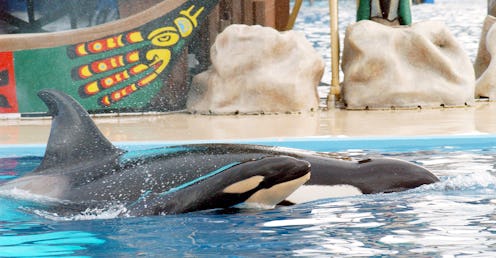News
SeaWorld's Worst Nightmare Is Here
Ever since last year's release of Blackfish, SeaWorld must have been waiting with bated breath for a political response. Now, a proposed bill banning orca captivation in California is here: Richard Bloom, a Democratic Assemblyman for Santa Monica, will introduce the "Orca Welfare and Safety Act" Friday. The staggeringly successful, Netflix-distributed documentary Blackfish sparked a huge backlash with its portrayal of the captivity of SeaWorld orcas (a.k.a. killer whales.) It contended that the deaths and injury of several SeaWorld trainers can be blamed on the tight, confined spaces the chain's orcas are kept in for decades, sparking them to become psychotic.
The bill would render it illegal to capture, hold, or use an orca for entertainment purposes – think Shamu. If passed, the legislation wouldn't necessitate the removal of all orcas from all SeaWorld locations, but would require 10 orcas to be taken from SeaWorld's San Diego marine park.
Those 10 orcas, according to the proposed legislation, would be realized back into the wild if possible. If they weren't in physical shape to do so, they would be kept in a rehabilitation center and not used for performance purposes. And depending on the outcome of the bill, a political ripple effect targeting the other SeaWorld locations is entirely possible.
Make no mistake: This legislation is in direct response to what's been dubbed the "Blackfish effect." The film's director, Gabriela Cowperthwaite, even helped draft the bill with assemblyman Bloom. After the film's 2013 release, animal-rights groups like PETA (and, um, Alec Baldwin) placed fresh pressure on SeaWorld to end their orca shows and release the animals back into captivity. As Bustle reported:
Most of the world’s captured orcas live in SeaWorld facilities, where they’ve been bred with one another since their ancestors’ capture. There, they perform for food, and are kept in marine pools the size of a swimming pool – a tiny, tiny fraction of the amount of space your average wild orca swims through every day. At night, they’re kept in dark isolation.
Meanwhile, orcas have caused the deaths of a handful of SeaWorld and SeaWorld-affiliated trainers. Animal rights organizations like PETA claim that the long-term captivity and poor living conditions lead to the orcas becoming highly aggressive and even psychotic.
SeaWorld’s side of the story is that the orcas are happy, friendly animals who love their trainers, the rush of performing, and are given enough space to roam. In Blackfish, several trainers attest that they believed that while working there.
In the first half of 2013 alone since Blackfish came out, SeaWorld’s visitor numbers dropped by close to 10 percent — net losses of $15.9 million compared to the year before.
Last Thanksgiving, there were calls to ban a SeaWorld float at the Macy's Parade. Later, a number of performers pulled out of SeaWorld's February performance series in protest, including the Barenaked Ladies, Willie Nelson, and Heart.
And last month, New York State proposed legislation that would ban the captivity of orcas for entertainment purposes. It's a purely symbolic gesture of support, though, because New York State doesn't actually have any captive orcas.
In a statement, California lawmaker Bloom explained his proposed bill: “There is no justification for the continued captive display of orcas for entertainment purposes," he said. "These beautiful creatures are much too large and far too intelligent to be confined in small, concrete pens for their entire lives. It is time to end the practice of keeping orcas captive for human amusement.”
